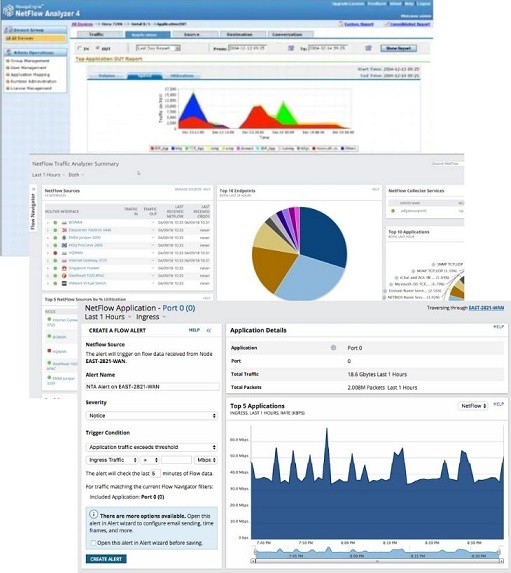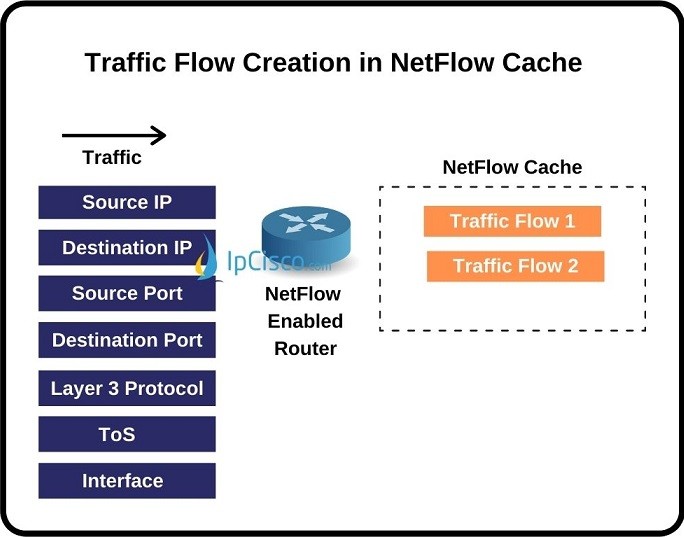- COURSES
- SPECIALS
- BLOG
- MEMBERS
- SHOP
- ABOUT
- ENROLL HERE

Table of Contents
In this lesson, we will learn What is NetFlow and we will see Netflow Cisco Configuration. Neflow is a network that is used to monitor the network and to collect ip traffic information. By analyzing your network traffic, Netflow gives you a picture of the network. It has developed by Cisco. There is also an enhanced version named Flexible NetFlow.
Netflow gives the answers of the questions related with network IP traffic. These questions are:
By answering these questions, Netflow provides a detailed network behavior view. With the help of Netflow, you can determine how your network resources are being used.
Before Netflow, network engineers were using SNMP (Simple Network Management Protocol) for network monitoring and network analyze. SNMP is good at Network monitoring but not good at in network analyze. So, Netflow is started to used.
Traffic Flow is basically a sequence of packets from a source to a destination in networking. In other words, if two nodes are communicating, a flow refers to any connection or connection-like communication channel.
So how can we define a traffic flow? Which attributes are used to define traffic flow? The seven attributes that are inspected and used to create traffic flow are given below:

There are three Netflow Components used for different purposes. These Netflow Components are given below:
Flow Exporter is an appliance or a Netflow enabled device that generates traffic flow records. Flow Exporter also exports these records to the Flow Collector periodically.
Flow Collector is an appliance or a program on a server that collects the traffic flow that is sent by Flow Exporter, stores these flows and prepares them for processing.
Flow Application is the application that analyze the traffic flow and produce results, reports, alerts etc.
We have talked about what is Netflow and we have seen the Netflow components. Now, it is time to learn how does Netflow Work?
As we have discussed above, there are three common components of Netflow.
Firstly, the Flow Exporter sends the flow information to the Flow Collector. This process is done periodically, in other words Flow Exporter sends traffic to the Flow Collector in certain periods. By the way the transmission protocol used for this data transfer is UDP (User Datagram Protocol).
UDP Port 2055 is the common port used for NetFlow. Beside this port, 9555, 9995,9025 and 9026 is also used. For IPFIX, UDP Port 4739 is used.
When the traffic flow comes to Flow Collector, Flow Collector gets this flow and stores this flow in its databases. Flow Collector also prepares this flow for the Flow Analyzer and sends the flow to it.
At the Flow Analyzer, the traffic flow is analyzed by the Flow Analyzer. As a result, different reports and alerts are created that shows the behavior of the network traffic flow.
Netflow has developed by Cisco in 1996. After that, this protocol has developed times and times as backward compatible with the other versions.
Different versions has different Netflow record fields. This depends on the Netflow version supported by Netflow Exporter.
So, what are the versions of Netflow? Let’s explain each version one by one.
Version 1: The first version that is restricted to IPv4.
Version 2,3,4: The versions used by Cisco internally and never released.
Version 5: The version that is commonly deployed and standard. It has been used by many other vendors. Restricted to IPv4.
Version 6: The version that is no longer supported by Cisco.
Version 7: The version similar to version 5 but it does not include AS, interface, TCP Flag & TOS information.
Version 8: The version uses several aggregation forms and reduces resource usage.
Version 9: The Netflow version that is template based and supported by recent routers. Used for IPv4, IPv6, MPLS, BGP Next Hop traffic flows. Netflow Version 9 has some advantages for Security, Traffic Analyzes and Multicast. It is also flexible and has extendible file export format. It is easy to support additional fields for this version.
There are many benefits of using Netflow both for Service Provider and Users. These Netflow benefits are given below:
We have learned what is Netflow and Why we use it in the previous lesson. Now, it is time to learn How to Configure Netflow on Cisco Devices? Here, we will see Netflow Cisco Configuration in four steps. These Configuration steps are given below:
Now, let’s see the Netflow commands used in these steps one by one.
In Netflow Cisco Configuration, the first step is enabling Netflow Export on the Flow Exporter appliance or device. To enable Netflow Export on the device, we will use the below commands:
To set flow destination IP address, we will use the below command. Here, we will set Netflow Collector’s IP Address as destination IP address.
Router (config) # ip flow-export destination <Netflow Collector’s IP Address>
To set flow source IP address, we will use the below command. Here, we will set Loopback Interface IP Address as source IP address.
Router (config) # ip flow-export source <Loopback Interface IP Address>
To set Netflow version, we will use the below command. Here, we will set the version as Netflow version 9. You can use 5 or 7 instead.
Router (config) # ip flow-export version 9
We will set the timout values for active and inactive with the below commands.
Router (config) # ip flow-cache timeout active 1
Router (config) # ip flow-cache timeout inactive 15
We will also use the below command to enable SNMP ifIndex persistence globally.
Router (config) # snmp-server ifindex persist
We need to enable the interfaces that we would like to monitor with the “ip flow ingress” command under each layer 3 interfaces.
Router (config) # interface <interface>
Router (config-if) # ip flow ingress
As an optional configuration steps, we can also use the below commands for including BGP Origin AS, MAC Addresses and VLANs.
Router (config) # ip flow-export version 9 origin-as
Router (config) # ip flow-capture mac-addresses
Router (config) # ip flow-capture vlan-id
There are various show commands used to verify Netflow Configuration. The most commons are given below:
In this lesson, we have learned the basic steps of Netflow Cisco Configuration on Cisco IOS. There are different configuration steps for other Cisco Operating Systems. You can learn how to configure Netconf on different Cisco devices from the related document on Cisco Website. You can view this article here.
Leave a Reply